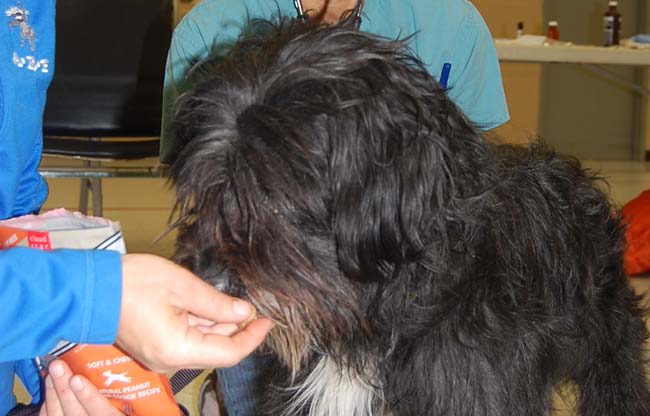ARF is the word for these patients

By Colleen Toulouse
SAGAMOK – The patient left the clinic after his annual checkup. He had received a vaccination, a prescription for an embarrassing rash and a bag of peanut butter treats.
He barked, possibly his version of “miigwetch”, and headed home on his leash with his owner.
Like most of the dogs at the Pet Pamper and Wellness Day, Moonlight wagged his tail and jumped playfully on his hind legs while receiving supportive care by the Animal Rescue Foundation of Ontario (ARF Ontario) volunteer team.
Forty dogs and half a dozen cats were checked on Nov. 8 by ARF Ontario, a organization that works with First Nations and rural communities to bring veterinarians into communities and find new homes for unwanted animals.
One ARF team worked out of the Multi-educational Centre and another toured the community, providing services for Elders and their pets and vaccinating roaming dogs. Pet owners paid $30 for vaccinations
“If a community does not have an animal-adoption building or a close-proximity humane society, or – like Sagamok — there is just one person doing the animal bylaws, we will work with them,” said ARF volunteer Laurie Ristmae. “If we have the necessary time and resources, and a willing partnership with the community.”
The organization is now working at full capacity in 15 communities and encourages communities to be specific in identifying their needs when requesting ARF assistance.
“Sagamok is a good example,” Ristmae says. “ One morning I opened up my e-mails and found a note from Stanford Owl: ‘Here’s what I’m doing, here’s the numbers and here’s what we are facing. What can you recommend?’”
She often receives concerns about packs of roaming dogs. While acknowledging that roaming dogs can play a role in keeping other animals away, Ristmae says community members can help with animal control.
“I think everyone has to look at themselves, their own environment, their own area and say ‘I can tackle this one thing. I can look at the dogs on my property and say what can I be doing?'”
Ristmae encourages people to focus on what they’re doing to provide adequate shelter, access to food and exercise for their pets.
Her most common inquiries are about access to affordable spay/neuter services for owned or roaming community dogs.
“I would love to come in,” she says, “and I have volunteers that would come in and set up in the community centre to provide accessible spay and neuter for every dog and cat. The College of Veterinarians has strict guidelines and restrictions about these volunteer services. What communities can do is contact CVO (www.cvo.org) and say ‘This is what our community needs to make it safe and healthy!’
“The people coming into the clinic are the ones that really want their dogs and cats to be healthy. They love their dogs and are good pet owners, and recognize healthy pets are part of overall wellness in their family and community.”
For more information, please visit http://www.arfontario.com/


